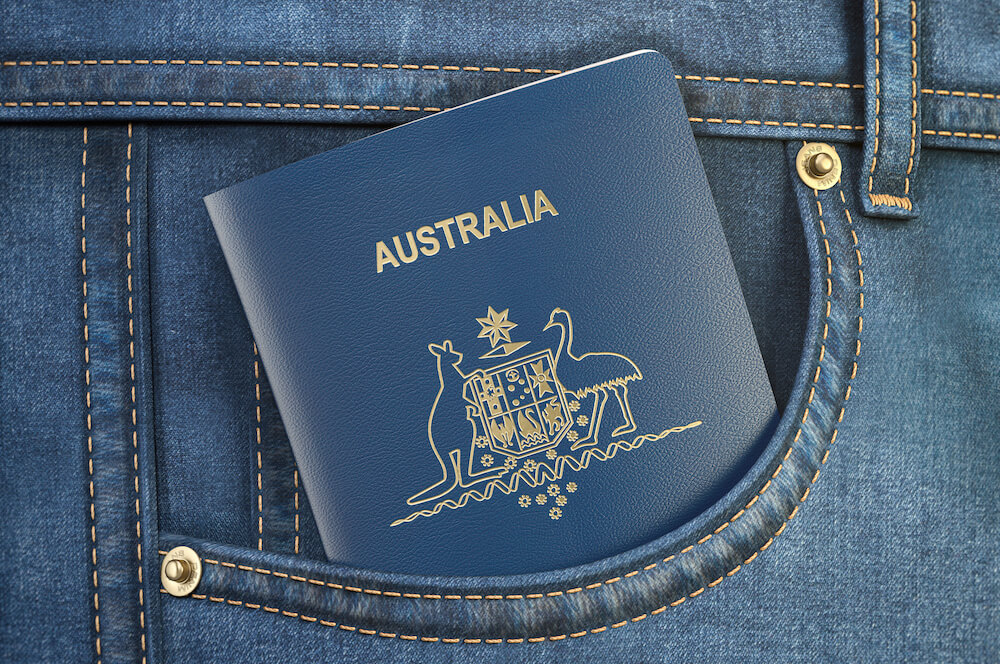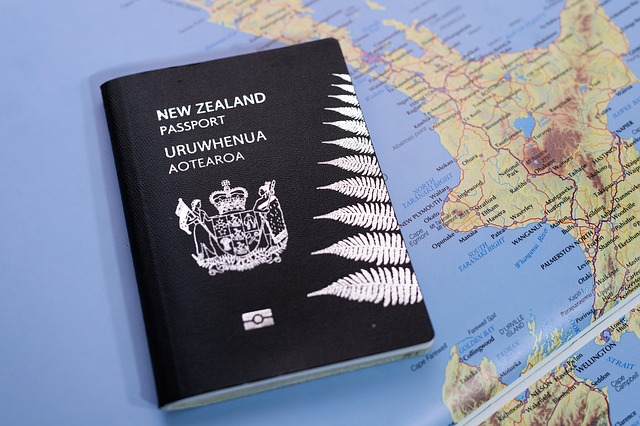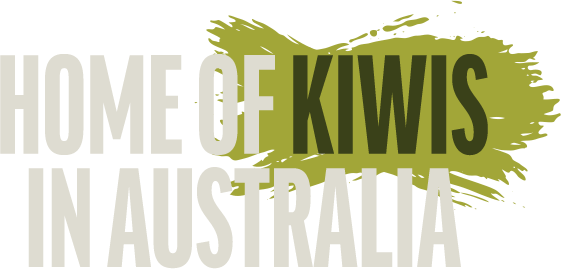
- New Australian Citizenship Pathway for New Zealanders
- Getting Australian Citizenship for Kiwis- Dual Citizenship
- Getting a Permanent Visa in Australia as a Kiwi
- Child & Adoption Visas
- Partner Visas for Kiwis in Australia
- Skilled Independent Visa (subclass 189) New Zealand Stream
- Resident Return Visa
- Family Visas in Australia for New Zealanders
- Skilled Work Visas in Australia

A new fast-track to Australian citizenship has been announced.
New Zealanders living in Australia no longer need to become Australian permanent residents before applying for Australian citizenship.
This represents a major change to previous immigration rules and paves the way for many more Kiwis to become Australian citizens. In short, it’s a huge win for our community.
There are many benefits associated with Australian citizenship, including greater access to grants, certain Government jobs, and higher education loans.
Australian Prime Minister Anthony Albanese said Australia and New Zealand have a “deep friendship” and acknowledged the many Kiwis currently raising families and building their lives in Australia.
Eligibility
New Zealanders who have been living in Australia for over four years can apply directly for citizenship from 1 July 2023.
Salary thresholds and date of arrival limitations no longer apply.
You will be eligible for citizenship if:
- You have lived in Australia for four years or more on 1 July 2023
- You haven’t spent more than 12 months outside of Australia during the four-year period
- You haven’t spent more than 90 days outside of Australia in the 12 months prior to lodging your citizenship application
- You pass the immigration character test
Some New Zealanders who settled in Australia before 26 February 2001 may already be entitled to citizenship. If you’re one of these people, you won’t have to wait until 1 July 2023 to apply.
Dual Citizenship
New Zealanders can hold dual Australian and Kiwi citizenship. You will have both passports and can enjoy the benefits of citizenship in both countries.
Fees
The citizenship application fee is $490 per adult ($300 if you are 60 years or older). Children under 15 can apply free of charge at the same time as their parents.
You can use a Registered Migration Agent to manage your application. There is an additional fee associated with this service, but an Agent will take the stress out of the process for you and liaise with the Department of Home Affairs on your behalf.
Our friends at True Blue Migration Services offer free assessments, if you want to check your eligibility and discuss your options.
Disclaimer: The information displayed on these pages is intended to provide a general overview of some Australian visa types. It is not a substitute for tailored, professional advice relating to your own personal circumstances. There are dozens of Australian visa subclasses; we refer to only a narrow selection here. Migration policies and regulations change frequently. We are not responsible for any errors or omissions relating to the generic information supplied here. You should always seek up-to-date advice from a Registered Migration Agent or refer to the Department of Home Affairs website prior to lodging an application. For more information visit www.truebluemigration.com

Getting Australian Citizenship for Kiwis- Dual Citizenship
Another piece of good news – if you choose to become an Australian citizen, you automatically gain dual citizenship, and there is no need for you to give up your New Zealand passport. The Australian government prefers Australian citizens to travel in and out of Australia with their Australian passports – so, if you choose to holiday in New Zealand, you should probably take both passports with you.
The process for getting citizenship in Australia differs for kids and for adults. We have a look at both, and try to explain the difference! If you’re an adult and you’ve received your permanent residency visa. The next step is applying for Australian citizenship.
Depending on the type of visa you have received then either you or you and your family can apply for citizenship together. Once you are an Australian citizen, you must vote in Australian elections, you will be entitled to Australian social security benefits like Centrelink and university fee loans like HECS and FEE-HELP, and can apply for work in the Federal Government.
Children born in Australia
Citizenship for children born in Australia to Kiwis can be a little confusing to understand, as it depends on what kind of visa the parent holds at the time of the child’s birth.
BELOW IS SOME INFORMATION ON HOW TO DECIDE IF YOUR CHILD IS AN AUSTRALIAN CITIZEN:
- born in Australia on or after 27 February 2001 and you held an Australian permanent resident visa or were present in Australia on 26 February 2001 as the holder of a Special Category visa, or
- born in Australia between 1 September 1994 and 26 February 2001 and you held a permanent visa or a Special Category visa, or
- born in Australia between 26 January 1949 and 19 August 1986 unless you or your spouse were entitled to diplomatic privileges, or
- born in Australia and reached 10 years of age having lived in Australia most of their life.
As it is possible to hold dual citizenship, we recommend that you apply for New Zealand citizenship by descent for your child born in Australia, and should you continue to reside in Australia permanently for the first ten years, then your child will automatically receive Australian citizenship. The next step would be to apply for evidence of citizenship in order to get an Australian passport.
If either parent is an Australian permanent resident or citizen, your child will automatically be considered an Australian citizen.
So if your child was born in Australia to a New Zealand Citizen (who is a New Zealand Citizen by birth or grant) wants to travel overseas before the magic age of 10. THEN apply for New Zealand citizen by descent and a New Zealand Passport to travel until the age of 10 then apply for an Australian passport.
Citizenship for Adults
There are two categories of eligibility:
- Form 1300t Australian citizenship – General eligibility (221KB PDF)for applicants aged 18 years and over and under 60 years of age.
- Form 1290 Australian citizenship – Other situations (238KB PDF)for applicants aged under 18 years, applicants aged 60 years or over, or applicants in special circumstances.
After you’ve been living in Australia for 4 years and had your permanent residency visa for at least 1 year, you can apply for Australian citizenship! You will need to make sure that you haven’t left Australia for more than 3 months (90 days) in the year before you apply.
The application is either online or paper application form. You will need identity, character and supporting documents to be included in your application.
The current fee for citizenship application is $285 AUD unless you are eligible for a concession.
STEPS TO CITIZENSHIP:
- Apply online or by paper with all documents and pay the fee. Wait for the approval letter.
- Wait for test date which there are practice tests online and relates to life in Australia and Australian Values, the letter you receive will direct you to study materials. Only 15 out of 20 to pass and it is computer multi-choice.
- At the test appointment you have an interview with Migration and they will need to see your original documents.
- Wait for the ceremony, which is held at your nearest location, normally takes 30 minutes.
- The process from application to ceremony can take up to 18 months, but it is worth the wait.
During the ceremony, you will be asked to make the Australian Citizenship Pledge and will be given a citizenship certificate.
Congratulations! Becoming an Australian citizen can be a long, expensive and somewhat stressful journey, but the benefits often outweigh the drawbacks, and once you have become an Australian citizen, you can rest assured that you have a home in Australia for as long as you wish and can come and go to and from New Zealand and Australia as you please.
People who visited this area also visited: Transfer Your KiwiSaver to Australia, Temporary Early Release of Super, Global Money Transfers – Fee Free*
Disclaimer: The information displayed on these pages is intended to provide a general overview of some Australian visa types. It is not a substitute for tailored, professional advice relating to your own personal circumstances. There are dozens of Australian visa subclasses; we refer to only a narrow selection here. Migration policies and regulations change frequently. We are not responsible for any errors or omissions relating to the generic information supplied here. You should always seek up-to-date advice from a Registered Migration Agent or refer to the Department of Home Affairs website prior to lodging an application.

Getting a Permanent Visa in Australia as a Kiwi
Types of Visas
The type of permanent visa you get in Australia will depend on your circumstances once you have moved to Australia. There are many types of permanent visas – too many to list. Some types of permanent visas require sponsorship – that is, someone who is an Australian resident or citizen over 18 years of age that is willing to financially support your application for a set period of time. Some types of permanent visas require certain skills or for you to be able to do certain kinds of jobs which the Australian government considers desirable. Some types of permanent visas are “points tested”, which gives factors such as your age, language skills, qualifications and work experience points according to how desirable the Australian government thinks they are (for example, good English skills give more points than poor English skills).
Confusingly enough, being a permanent resident and being a “resident for tax purposes” are completely different things! Please see our section on Tax in Aus to learn about being a “resident for tax purposes”.
If you are looking at trying to obtain a permanent residence visa for Australia, we recommend you go to a registered migration agent, who will be able to assess your individual situation and which visa would best suit your needs.
There are many types of visas available in Australia and their requirements change quite frequently, a professional opinion will be able to assist you in finding the quickest path to permanent residency for you. And, since permanent visa applications can be costly and take ages, a Registered Migration Agent can help you avoid having your application rejected. Remember you do not get a refund if you complete the wrong visa application.
- Skilled Independent Visa for Kiwis
- Skilled Work Visas
- Family Visas
- Partner Visas
- Child & Adoption Visas
- Parent Visas
- Relative Visas
- Carer Visas
You will notice that your “permanent” residency visa has an expiry date. Surely you haven’t slogged through all those mountains of paperwork and visa fees for five years or less? No, you haven’t! After you have had a permanent residence visa and have been living happily in Australia for at least 2 out of the last 5 years, you will be eligible to apply for a Resident Return Visa. This will allow you to travel in and out of Australia freely without having to re-apply for the visa that gave you your permanent residency in Australia. Once the RRV has been granted you can then sponsor your children.
IMPORTANT FOR KIWIS:
This includes New Zealand Citizens who travelled to Australia for a holiday even as a child before 1 September 1994, then if you arrived back into Australia after 26 February 2001, then you can apply for a Resident Return Visa which expires after 5 Years and you can travel overseas….BIG BONUS….. after one year then you can apply for Australian Citizenship.


Child & Adoption Visas for Kiwis in Australia
Child and adoption visas can be granted to people under the age of 18, and can differ depending on whether they are financially dependent on their sponsor, an orphan, or have been adopted by an Australian Citizen, Permanent Resident or a Protected Special Category Visa Holder.
There are many types of visas available in Australia and their requirements change quite frequently, a professional opinion will be able to assist you in finding the quickest path to permanent residency for you. And, since permanent visa applications can be costly and take ages, a Registered Migration Agent can help you avoid having your application rejected. Remember you do not get a refund if you complete the wrong visa application.


If you hold a 444 visa and you’re in a relationship with an Australian citizen or an Australian permanent resident, you may be eligible for an onshore partner visa.
You may be wondering why you’d want to apply for a partner visa when you already have work rights as a 444 holder. The benefit of this visa route is that it leads to permanent residency (PR). PR is a pathway to citizenship. Benefits of PR and citizenship include access to more job opportunities, reduced education costs and access to government grants and more support.
This partner visa (820/801) is a two-part application although you pay one visa application charge when you lodge the initial application.
Onshore partner visa eligibility
To be eligible for the 820/801 visa, you would either need to:
- have evidence of living together for the 12 months immediately prior to lodging the partner visa
- be married before you lodge the partner visa
- register your relationship in a state or territory of Australia that allows registration. Registration waives the 12-month cohabitation requirement.
Relationship Registration
The registration process is different in each state or territory, but common requirements are:
- you must both be aged 18 or over
- neither of you can be married to someone else (even if separated for a long time)
- you two must not be related by family
You do not need to hold relationship registration at the time of lodging the partner visa, but you must hold it prior to a decision being made on the visa application. You can choose to register your relationship in one state and then move to another state. Relationship registration is briefly explained here.
NSW relationship registration
To register in New South Wales, you’ll need to show that one of you is living in NSW. You’ll need to show specific forms of identification and proof of residence.
QLD relationship registration
Queensland registration requires you to demonstrate that at least one of you has lived in Queensland and you must be able to prove your ID and show evidence of living in QLD.
Victoria relationship registration
To register your relationship in Victoria, you’ll need to show that one of you has lived in Victoria for a short period with proof of residency, such as utility account or superannuation statements.
ACT relationship registration
Relationship registration in the Australian Capital Territory requires one of you to show two pieces of evidence of residence in the ACT.
South Australia relationship registration
To register in South Australia, you’ll need to show that one of you has been usually resident in South Australia.
Tasmania relationship registration
Tasmanian couples need to show that both people are living in Tasmania.
Western Australia and the Northern Territory
Unfortunately, relationship registration is not available for migration purposes in Western Australia or the Northern Territory.
Living together and showing partnership evidence
You must be living together when your partner visa is lodged (even if you are relying on the relationship registration to waive the 12 months) and continue to live together during the processing time. You need to show evidence of your shared life together, such as financial commitments, shared living arrangements and social recognition of your relationship. Not only do you need to gather evidence before lodging an application, you need to continue submitting evidence as your application progresses to show that your relationship is genuine and ongoing. We provide detailed instructions and lists of possible evidence you can show.
Lodging the PR component of your partner visa
Once granted the temporary partner visa (subclass 820), you will no longer hold a 444 visa. Your 820 visa remains in place until the PR part of your visa (subclass 801) is granted. You can only lodge the 801 part of your visa two years after lodging the initial application. At this time, you must provide Immigration with further evidence of your ongoing relationship in order to obtain the PR partner visa (801).
Pathway to citizenship
Once you are an Australian permanent resident, you can stay in the country indefinitely or apply for citizenship once you are eligible.
Children included in the 820/801 visa
Your dependent children can be included in an 820/801 partner visa application. You will need to have sole custody or legal permission from the child/ren’s other biological parent for them to be included in your 820/801 application.
Australian partner sponsor approval – pending
The Migration Amendment (Family Violence and Other Measures) Bill has been drafted and is pending approval. Once legislated, it will require your Australian partner to be approved as a sponsor before your 820/801 visa application can be lodged. As this will be a new step in all 820/801 applications, the processing time and cost of this sponsorship is not confirmed. As of yet (September 2020), we do not know when this new framework will be applied to partner visa applications.
Permanent residency straight away
Some couples can bypass the temporary visa (820) stage. If you have been living with your Australian partner for the three years immediately prior to lodging your application – or you have a child together and have lived together for the previous two years – you can apply for the 801 partner visa straight away.
Another option
If you arrived in Australia between Feb 2001 – Feb 2016, you have lived here for the past five years and have earned at least $53,900 for each of the past four financial years, you may be eligible for PR in your own right through the Skilled Independent visa (NZ Stream).
Split payment options available and may vary depending on the type of visa being applied for.
Disclaimer: The information displayed on these pages is intended to provide a general overview of some Australian visa types. It is not a substitute for tailored, professional advice relating to your own personal circumstances. There are dozens of Australian visa subclasses; we refer to only a narrow selection here. Migration policies and regulations change frequently. We are not responsible for any errors or omissions relating to the generic information supplied here. You should always seek up-to-date advice from a Registered Migration Agent or refer to the Department of Home Affairs website prior to lodging an application. For more information visit www.truebluemigration.com

Applications for the Skilled Independent Visa (subclass 189) New Zealand stream PR visa have been placed on hold until 1 July 2023. Read More »
A fast-track pathway to Australian citizenship will commence from 1 July 2023.
New Zealanders applying for Australian citizenship no longer need Australian Permanent residency first. The previous Subclass 189 New Zealand Stream visa is no longer in place. eligible, you can skip straight to citizenship.
There are many benefits associated with Australian citizenship, including voting rights, greater access to jobs and grants, and HECs loans.
Eligibility
Lean more about Australian citizenship eligibility (link to new/updated page) or contact our friends at True Blue Migration Services for a free assessment.
Split payment options available and may vary depending on the type of visa being applied for.
Disclaimer: The information displayed on these pages is intended to provide a general overview of some Australian visa types. It is not a substitute for tailored, professional advice relating to your own personal circumstances. There are dozens of Australian visa subclasses; we refer to only a narrow selection here. Migration policies and regulations change frequently. We are not responsible for any errors or omissions relating to the generic information supplied here. You should always seek up-to-date advice from a Registered Migration Agent or refer to the Department of Home Affairs website prior to lodging an application. For more information visit www.truebluemigration.com

New Zealand citizens who entered Australia before 1 September 1994 may be eligible for a Resident Return Visa (RRV).
A RRV is essentially a ‘travel facility’ granted to Australian permanent residents which allows them to enter and exit Australia.
Although you may not realise it, if you’re a New Zealand citizen who visited or spent time in Australia before 1 September 1994, you may be classed as a ‘former Australian permanent resident’. And because of this, you might be eligible to apply for a RRV.
Confusing, yes, but stick with us.
RRV applications can only be made individually. Dependent children and partners will need to make their own applications. This might mean that an RRV is not the best visa option for you.
If you’re eligible for an RRV, but your partner and children are not, they can apply for a different type of permanent residency visa later, such as an Australian partner visa. The Government application fee for partner visas is much higher than it is for 461 New Zealand family relationship visas, but the bonus is that you’ll all be on a pathway to PR.
Alternatively, you may all be eligible to apply for another option such as the 189 visa (New Zealand stream).
RRV eligibility for New Zealand citizens
To meet the requirements for this visa type, you must have:
- Entered Australia before 1 September 1994
- Must have a valid reason for then leaving Australia
- Must be residing in Australia at time of application
- You’ll need to show strong ‘ties of benefit’ to Australia
You might even be eligible if:
- You only visited for a holiday or short trip
- You were a child travelling on your parent’s passport
What are ties of benefit?
You’ll need to show that you have very strong ties to Australia. If you’re already living here or have family members living here, this should not be difficult.
Everyone’s individual circumstances are different, but ties of benefit can include:
Business links: You may own or run a business in Australia and employ people.
Personal ties: You could be in a relationship with an Australian citizen or have children living here. Perhaps you coach a local rugby team.
Employment ties: You might be employed here in a highly skilled role and be working full-time.
Compelling reasons for absence
If you were away from Australia for more than 5 years (continuous), you’ll need to provide a compelling reason for that absence.
It’s not necessary to give compelling reasons for all absences, just long periods over 5 years.
There’s no hard and fast definition of ‘compelling’ for migration purposes, but common reasons include:
- Work and study commitments outside of Australia. You may be able to demonstrate that the experience you gained overseas is necessary for the work you do in Australia.
- You were away from Australia due to an important personal event.
- You were in a relationship with an Australian citizen and both lived overseas for a while.
- The death of a family member, or severe illness, kept you from returning.
The key here is really to show that you intended to return to Australia permanently and that you were here before, prior to 1 September 1994.
It will be down to your Case Officer to make a determination on whether the reasons for your absence are compelling enough and whether you do indeed have strong ties of benefit to Australia.
Free Assessment
The easiest way to check your eligibility is through a free assessment with a Registered Migration Agent. If you’re not eligible for an RRV, there may be other Australian residency pathways open to you.
Split payment options available and may vary depending on the type of visa being applied for.
Disclaimer: The information displayed on these pages is intended to provide a general overview of some Australian visa types. It is not a substitute for tailored, professional advice relating to your own personal circumstances. There are dozens of Australian visa subclasses; we refer to only a narrow selection here. Migration policies and regulations change frequently. We are not responsible for any errors or omissions relating to the generic information supplied here. You should always seek up-to-date advice from a Registered Migration Agent or refer to the Department of Home Affairs website prior to lodging an application. For more information visit www.truebluemigration.com

461 visa eligibility
If you hold a NZ 444 visa and you are in a relationship with an overseas national, you may be able to sponsor them on a Subclass 461 New Zealand Citizen Family Relationship visa.
461 visa – partner eligibility
To be eligible for a 461 visa, you would either need to have evidence of living together for at least six months or be married before you lodge the visa. You must demonstrate to Immigration that you are in a committed and ongoing relationship. As well as showing evidence of living together, you’ll need to demonstrate how you share your finances, how you depend on one another and how you two are recognised by family and friends as a genuine couple. Unlike other partner visas, registration of your relationship in a state or territory of Australia does NOT waives the requirement of six months of living together.
Your partner would need to hold a visa that allows them to lodge another visa onshore, that is, a visa that does NOT have an 8503 NO FURTHER STAY condition.
Your partner would need to meet health and character requirements and have no outstanding Australian Government debts.
461 visa – family members
As a 444 visa holder, you can also sponsor eligible members of your family unit on 461 visas. This includes children aged 18 and over, provided the children are single and have not been in a de facto relationship. You can also sponsor your partner’s dependent children.
461 visa – bridging visas
Once the 461 visa is lodged, your partner will be issued with an associated bridging visa. It is crucial to understand that their bridging visa only comes into effect at the end of their current visa. For example, if your partner holds an employer sponsored 482 visa that expires in 2023, they must remain on this visa whilst their 461 visa is processing. They cannot transition onto their bridging visa. The conditions of their bridging visa will vary depending on the visa held at the time of lodgement. They may or may not get work rights or may have restrictions as to which employer they can work for, and for how long.
461 visa – temporary residency
The 461 is a temporary visa that allows your partner to remain in Australia for five years. It can be applied for again in the future, but it does not provide a pathway to PR. If you are eligible for PR through the Skilled Independent visa 189 (NZ Stream) you can include your partner in this application, and you will both obtain PR if the NZ 189 visa is granted. You can register the relationship in this circumstance waiving the requirement to show 12 months evidence of living together (if required).
Could you be an Australian permanent resident?
Even if you hold a 444 visa, you may be an Australian permanent resident without knowing it! If you were in Australia on 26 February 2001 (or lived there for at least 12 months before), you are very likely to be an ‘eligible New Zealander’. This means that you hold Australian permanent residency. In this case, you may be able to sponsor your partner on a Partner Visa (Subclass 820 and 801) visa. You would not be able to sponsor them on a 461 visa in this case. If you are unsure of when you were in Australia, you would need to request overseas travel records from Immigration to confirm your visa status, as you may appear as a temporary resident on VEVO.
461 visa – work and study rights
The 461 visa provides full work and study rights. However, your partner is not entitled to fee support.
461 visa – relationship breakdown
If your relationship breaks down, your partner can apply for a further five year 461 provided they are not in a new relationship. If they decide to apply for a new 461 visa, they must continue to meet health and character requirements and show that they have maintained residency in Australia (two out of the last five years). There is no limitation on you sponsoring a new partner on a 461 visa.
Split payment options available and may vary depending on the type of visa being applied for.
Disclaimer: The information displayed on these pages is intended to provide a general overview of some Australian visa types. It is not a substitute for tailored, professional advice relating to your own personal circumstances. There are dozens of Australian visa subclasses; we refer to only a narrow selection here. Migration policies and regulations change frequently. We are not responsible for any errors or omissions relating to the generic information supplied here. You should always seek up-to-date advice from a Registered Migration Agent or refer to the Department of Home Affairs website prior to lodging an application. For more information visit www.truebluemigration.com

Skilled Work Visas in Australia
There are many kinds of work visas available into Australia, all with distinctive requirements.
There are Sponsored Skilled Visas:
- Temporary Skill Shortage – temporary visa one to four years duration.
- Employer Nomination Scheme – permanent visa
- Regional Sponsored Migration Service –permanent visa to work in regional areas.
The above visa list is not exhaustive, they include required skills, qualifications to be assessed, English tested and occupations need to be on a list of skilled occupations, points test and in some cases need to apply for an Expression of Interest and pass health and character tests and/or be sponsored.
It is highly advisable to contact a Registered Migration Agent to work out the best pathway depending on individual circumstances.
Categories
- Accommodation
- Babies & children
- Child care & early learning in australia
- Community services
- Credit checks
- Driver’s licences in australia
- Education in australia
- Financial stuff
- Government benefits in australia
- Health
- Immigration & residency
- Insurance information
- Legal system of australia
- Marriage & relationships in australia
- Pensions – what you need to know
- Police clearances
- Responsible service of alcohol
- Superannuation – what you need to know
- Tax in aus
- Transporting your belongings to australia
- Utilities – getting connected
- What to bring with you
- Working with children checks





